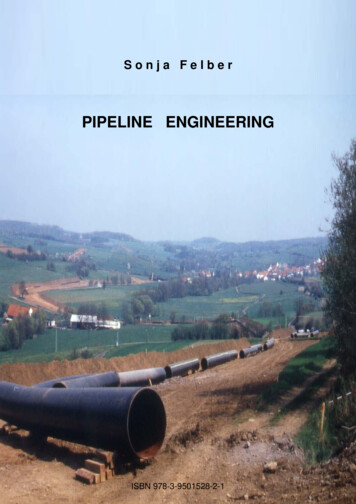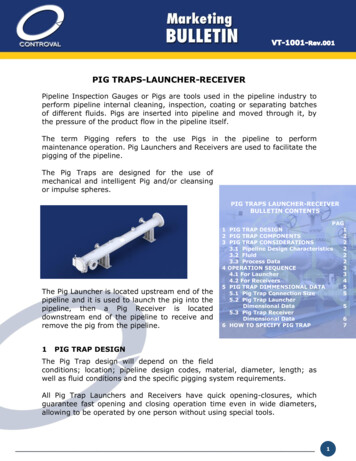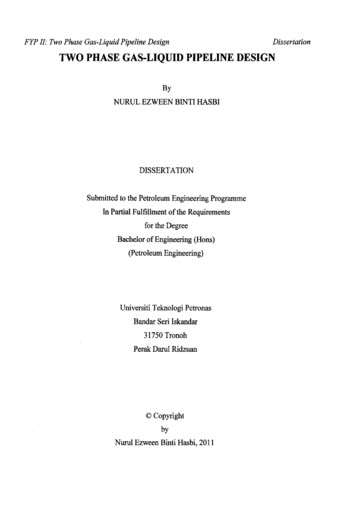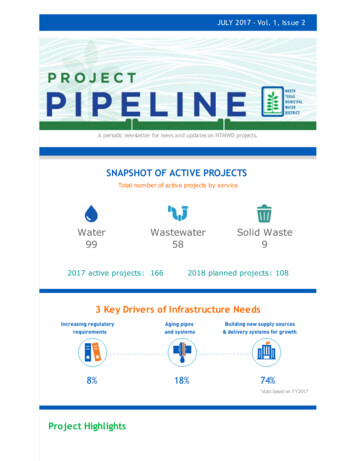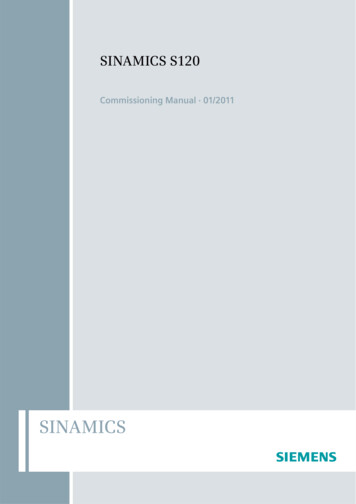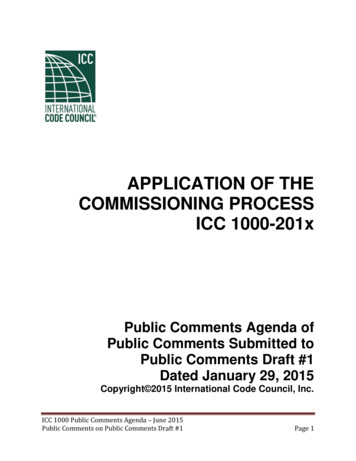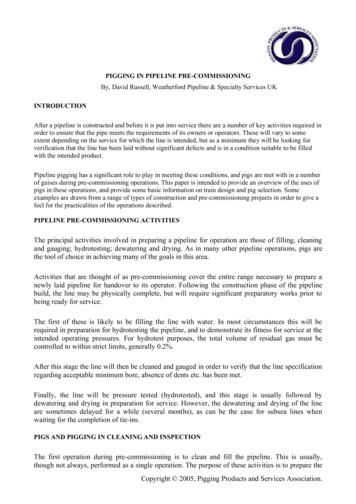
Transcription
PIGGING IN PIPELINE PRE-COMMISSIONINGBy, David Russell, Weatherford Pipeline & Specialty Services UKINTRODUCTIONAfter a pipeline is constructed and before it is put into service there are a number of key activities required inorder to ensure that the pipe meets the requirements of its owners or operators. These will vary to someextent depending on the service for which the line is intended, but as a minimum they will be looking forverification that the line has been laid without significant defects and is in a condition suitable to be filledwith the intended product.Pipeline pigging has a significant role to play in meeting these conditions, and pigs are met with in a numberof guises during pre-commissioning operations. This paper is intended to provide an overview of the uses ofpigs in these operations, and provide some basic information on train design and pig selection. Someexamples are drawn from a range of types of construction and pre-commissioning projects in order to give afeel for the practicalities of the operations described.PIPELINE PRE-COMMISSIONING ACTIVITIESThe principal activities involved in preparing a pipeline for operation are those of filling, cleaningand gauging; hydrotesting; dewatering and drying. As in many other pipeline operations, pigs arethe tool of choice in achieving many of the goals in this area.Activities that are thought of as pre-commissioning cover the entire range necessary to prepare anewly laid pipeline for handover to its operator. Following the construction phase of the pipelinebuild, the line may be physically complete, but will require significant preparatory works prior tobeing ready for service.The first of these is likely to be filling the line with water. In most circumstances this will berequired in preparation for hydrotesting the pipeline, and to demonstrate its fitness for service at theintended operating pressures. For hydrotest purposes, the total volume of residual gas must becontrolled to within strict limits, generally 0.2%.After this stage the line will then be cleaned and gauged in order to verify that the line specificationregarding acceptable minimum bore, absence of dents etc. has been met.Finally, the line will be pressure tested (hydrotested), and this stage is usually followed bydewatering and drying in preparation for service. However, the dewatering and drying of the lineare sometimes delayed for a while (several months), as can be the case for subsea lines whenwaiting for the completion of tie-ins.PIGS AND PIGGING IN CLEANING AND INSPECTIONThe first operation during pre-commissioning is to clean and fill the pipeline. This is usually,though not always, performed as a single operation. The purpose of these activities is to prepare theCopyright 2005, Pigging Products and Services Association.
line for hydrotesting and to ensure that the line is clean for the use of inspection tools, or that atleast that debris left over from the construction phase (potentially damaging to the pipeline orassociated process equipment) is cleared out. The owner and/or operator of the line will generallyset criteria for cleanliness depending on the intended purpose of the line.As would normally be the case in the operational use of pigs for pipeline cleaning, the pigs will beselected based on the perceived duty, and their effectiveness gauged based on the quantities ofdebris produced into the receiving trap.Pig selection for this purpose is the same as selection for any cleaning job. Generally, the engineerswill be reasonably confident that there are not large quantities of extraneous material present in thepipeline. Brush pigs may be selected if some time has passed between the line being laid and thispre-commissioning operation, in order to produce a more aggressive cleaning action. One or moretrains would be run depending on the quantities of debris being produced, and this would becontinued until the client representative was satisfied with the state of the line.Fig. 1 – Cleaning and Filling a New PipelineA steel pipeline with no internal coating can be cleaned with a pig train similar to that shown inFigure 1. Brush pigs will rub the internal surface of the pipeline, removing rust and loose mill scale,whilst the pig disks and water flow move the debris along the pipeline.Pipelines which have been coated internally cannot be cleaned with brush pigs as this wouldpotentially damage the coating. In this case the only method by which debris can be removed is byusing pig discs and water flow. By the same token, however, coated pipelines will tend to have lessdebris to clear out. Rust and scale in particular should not be present in any significant way.Achieving the required cleaning specification places requirements on the pig operations similar tothose that are generally observed in operational pigging – speed is best controlled to between 0.5 to1.0 m/s. Of course for these types of operations, the pig trains are generally being pumped throughthe line, so that this control is easily achievable.Copyright 2005, Pigging Products and Services Association.
Some bypass of water past the leading pig is more or less unavoidable, but this is felt to be beneficial, even,in flushing debris along in front of the pig train.Once cleaning and filling are completed, the next stage will often be to run a gauging or caliper pig.The aim of this operation will be to meet the requirement to prove the continuous diameter of thepipeline, i.e. the absence of any significant dents, ovalities or other defects caused during theconstruction phase.Fig. 2 – Gauging a New PipelineThis process also provides a baseline for the pipeline at the date of construction. A number ofmethods can be used to achieve this. The simplest, and historically most frequently used, are gaugepigs. The design of these is typically that of a standard pig, with the addition of a thin aluminiumdisk, typically mounted behind the front set of pigging disks (Figure 2). This plate is machined to apre-set tolerance diameter (generally 95 – 97% of the pipeline internal diameter). Any dents,buckles wrinkles or other out-of-roundness features that intrude into the pipeline by more than thiswill deform the gauge plate. The disk size will depend on the owner's required specification for thesize of defects to be considered tolerable. Sometimes the gauge disk will be cut into petals to allowfor local deformation of the plate.Restrictions beyond the tolerance established by the disk size will manifest themselves as damage to thegauge plate, so that any damage to the gauge plate is an indication that there is a dent or other unwantedfeature in the pipeline that will need further investigation. The nature of the damage can allow a skilledoperator to assess the probable nature of the defect. Pressure and/or flow rate records can help to offer arough indication of the position, and sometimes give additional data about the nature of any defect. Of courseon many occasions nothing concrete can be determined from these indications, and further investigativeaction will be needed to identify and locate the problem prior to remedial action being taken. Very often, precommissioning operators will run a second gauge pig to confirm the results in the hope that the damage fromthe first run was caused by a transient feature.Beyond this the decision may be taken to run a caliper pig or similar geometry tool capable ofproviding more detailed information regarding the position and nature of the restriction.The original electronic caliper tools consisted of multiple arms in contact with the pipe wall coupledto a single sensor, providing data on the maximum size of any intrusion into the line. ExperiencedCopyright 2005, Pigging Products and Services Association.
operators could determine the nature of the out-of-roundness feature encountered (i.e. whether dent,ovality, etc), and an approximate distance from the end of the line. More recent tools (e.g. Figure 3)have independent sensors on each arm and can provide more detailed profile information on thedefect and usually an indication of whether to expect the feature to be located on the top or bottomof the line.Fig. 3 - Weatherford’s MultiCalSM 360 multi-channel caliper toolThe alternative approach is to use records of volumes of water pumped to estimate the positionwhere the damage is most likely to have been caused, and to dig up the line for visual inspection.PIGS AND PIGGING IN PIPELINE FLOODING/FILLINGFor hydrotesting a new line, the quality of the filling operation is of major importance. Thespecification for fill water is that less than 0.2% of the pipeline volume can be air after the fillingoperation is complete. The reason for this is that the compressibility of the air has a significanteffect on the hydrotest operation, and can render results invalid in some cases.For this reason, it is not generally possible to control flooding using only a single pig. It is usual tospecify pigs that have good sealing characteristics, and to have two or more pigs in the train. Thistrain will usually be designed in a relatively conservative way, since the costs of having to repeatthe exercise may be significant.It should be remembered that for the purposes of pre-commissioning it is often necessary to usetreated fresh water, and that in many locations around the world, not only offshore, this may be hardto come by and/or expensive. Further, after biocides and corrosion inhibitors have been added to thewater, disposal may be an environmental issue. This is still an issue even in those situations where itis acceptable to use treated sea-water.Pig speed is an important consideration when filling a pipeline. Speeds that are too low or too highcan lead to situations where excessive bypass may occur, compromising the ability of the pig trainto meet the specification for gas content after filling is complete. Filling small diameter pipelines isusually not a problem as the volume output required from the pumping system is small; howeverwhen filling larger diameter pipelines this can be more difficult. Having sufficient pumps on handCopyright 2005, Pigging Products and Services Association.
to fill a 36" line or larger can be problematic, as flow rates of tens of cubic metres per second willbe required, and spare capacity will be needed to provide coverage for potential breakdowns, etc.After the line has been successfully flooded, the line is brought up to test pressure, to: verify the strength of the pipeline, and its ability to withstand the operatingpressure;verify that there are no significant leaks;find defects in equipment; andrelieve some of the stresses potentially induced during construction.Pigging plays no real role in this however, so further details of this are not covered in this paper.PIGS AND PIGGING IN PIPELINE DEWATERINGAfter the hydrotest is complete, the line may be left full of the (treated) test water for some time. Atsome stage prior to use however the pipe will need to have all of the water in it removed. For oilpipelines this is a straightforward process, generally performed as the final commissioning stage,i.e. production through the pipeline is used to force the water out of the line. For most oil pipelinesthe addition of small quantities of water to the first production is not likely to cause any significantproblems. In this case more often than not, a single pig will be used as the interface between thewater and the oil (Figure 4).Fig. 4 – Dewatering an Oil PipelineFor gas and process pipelines the situation is much more complicated. The presence of residualwater in lines can have very serious consequences, both in terms of the potential for corrosion tooccur, and as for the possibility that hydrates may form if water is present as the line is brought upto pressure.For this reason, the pig train used to dewater a line will usually consist of a number of elements,each with a specific aim.Copyright 2005, Pigging Products and Services Association.
Fig. 5 – Dewatering a Gas PipelineFirst will be a train of pigs designed to sweep as much water as possible out of the line (Figure 5).This train as shown consists of a number of bi-di pigs intended to sweep the bulk of the liquid outof the line. In cases where the water used to fill the line was sea-water, a slug of fresh water mightbe introduced into the line between the first two pigs in order to remove salt from the line. Again inthis case, production pressure is not available to move the pig train and significant compressionmust be available in order to propel the pig train. This is particularly the case for offshore lineswhere it will probably be necessary to overcome significant hydrostatic head to push the column ofwater out of the line.Dewatering requires a lot of horsepower and specialist equipment, especially on large diameterpipelines in deepwater. For example, a 36" diameter pipeline in 250m water depth requires around1000 m³ of air per minute at around 28 bar. Pressure is required not only to displace the water to aheight of 250m, but also to overcome the frictional losses in the distance from the sea to the piglauncher, the losses due to the pigs themselves, and frictional losses in moving the column of water(Figure 6). These flow rates are a consequence of the fact that the optimal speed for dewatering isabout the same as that for filling, i.e. around 0.5 to 1.0 m/s.Copyright 2005, Pigging Products and Services Association.
Fig. 6 – Dewatering HeadThis type of pigging operation is sufficient only as a first stage in dewatering a line. Even the best-designedpig train of this sort is likely to leave a film 0.1 to 1mm thick on the internal surface of a pipe. Over thelength of the line this can amount to a significant volume of free water in a line.A number of techniques are used to reduce this residual volume to an acceptable value. Not all ofthese require the use of pigs and are therefore not considered in any detail here, but they include airdrying and vacuum drying.Pigs have a role to play in air-drying as, very often, a series of foam swabs will be run in the lineduring air-drying operations. The first pigs pushed through may be bi-directional but most of theoperation will be performed using bare foam pigs. These have a dual action: they swab water off thepipe wall by absorbing it; and they also push the water out in front of the pig. Bare foam pigsbecome saturated quite soon, so that many such swabs will usually be run. This will continue until itappears that the swabs are not effectively removing any remaining water, when a final stage ofdrying by purging the line with dry air or nitrogen will proceed without pigs.An alternative to this in the final phase of drying is in running pig trains to batch hydrophilicchemicals through the line. The aim is to bring any moisture not removed from the line by pigs incontact with chemicals that will absorb water.Chemicals that are used for this purpose include methanol and glycol. Typically, slugs of methanolare placed in perhaps two batches in a train of four or five pigs, driven by nitrogen and withnitrogen between them (Figure 7). Standard calculations can be used to determine just how muchmethanol will be required to dry a given size and length of pipeline.Copyright 2005, Pigging Products and Services Association.
Fig. 7 – Methanol SwabbingThe pig train is pushed through the line using the nitrogen, either cryogenic nitrogen from tanks orgenerated on-site using membrane nitrogen units. As the pigs are received the methanol is divertedinto temporary storage tanks for analysis purposes. This analysis gives data on how much water iscontained within the methanol, allowing an estimate of how much water has been removed.Moreover, although this pig train will still have left a liquid film on the inside of the pipe, this filmwill have a very similar ratio of water to methanol as the recovered methanol, allowing estimates tobe made of the remaining water content in the line.SUMMARYWe have seen how the use of pigs can cover a large part of the range of pipeline pre-commissioningfunctions. Foam swabs are used for drying operations, brush pigs may be used for cleaning, and standard bidi pigs for batching and/or separation. Gauge pigs are used as a simple inspection technique, or moresophisticated electronic caliper pigs may be used for a similar purpose, and under some circumstancesintelligent pigs may be used to provide baseline data. Therefore, it should be remembered that the selectionof pigs for pipeline pre-commissioning purposes can be just as important an exercise as for operationalpipeline pigging and inspection.Copyright 2005, Pigging Products and Services Association.
Pipeline pigging has a significant role to play in meeting these conditions, and pigs are met with in a number of guises during pre-commissioning operations. This paper is intended to provide an overview of the uses of pigs in these operations, and provide some

